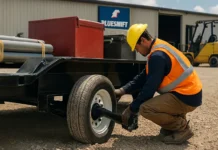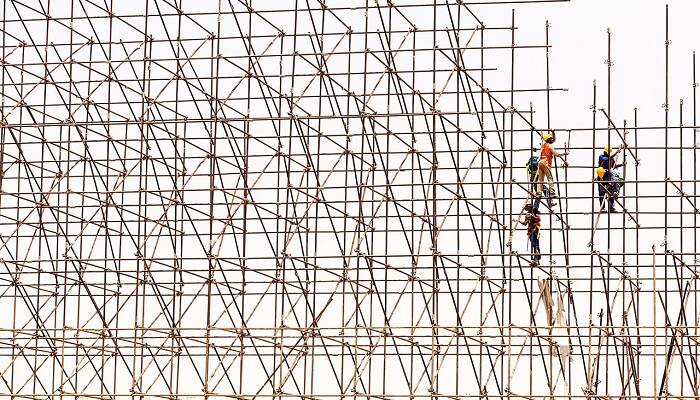Scaffolding plays a vital role in the construction industry, enabling workers to safely access high areas and complete complex tasks efficiently. Without the use of scaffolding, many construction projects would be nearly impossible or extremely dangerous to execute. In this article, we will explore the essential role of scaffolding in construction, its various types, safety considerations, and the importance of working with experienced scaffolding experts to ensure successful project completion.
The Importance of Scaffolding in Construction
Scaffolding plays a vital role in the construction industry for several reasons:
- Accessibility: One of the primary reasons scaffolding is crucial in construction is its ability to provide workers with safe access to elevated areas. Whether it’s a multi-story building, bridge, or industrial structure, scaffolding allows workers to reach heights that would otherwise be inaccessible or extremely hazardous to work on. By creating a stable and secure platform, scaffolding enables workers to perform tasks such as bricklaying, painting, electrical work, and roofing with ease and efficiency.
- Safety: Construction sites are inherently dangerous environments, with falls from height being one of the leading causes of workplace accidents and fatalities. Scaffolding serves as a critical safety measure, providing workers with a sturdy and level surface to stand on while working at heights. When adequately erected and maintained, scaffolding reduces the risk of falls and injuries, ensuring the well-being of construction workers. Scaffolding also often incorporates safety features such as guardrails, toe boards, and netting to enhance worker protection further.
- Efficiency: Scaffolding enhances safety and dramatically improves the efficiency of construction projects. By providing workers with a stable platform to work from, scaffolding allows tasks to be completed more quickly and with greater precision. Workers can move freely along the scaffolding, transporting materials and tools quickly, streamlining the construction process and reducing the time and labor required to complete the project. This increased efficiency translates into cost savings for project owners and faster project delivery timelines.
Types of Scaffolding
There are several types of scaffolding used in construction, each with its unique features and applications:
- Tube and Coupler Scaffolding: Tube and coupler scaffolding is one of the most versatile and widely used types of scaffolding in construction. It consists of steel tubes connected using couplers, creating a modular and adaptable framework. This type of scaffolding is highly customizable, allowing it to be configured to fit the specific requirements of any construction project. Tube and coupler scaffolding is known for its strength, stability, and ability to support heavy loads, making it suitable for various applications.
- System Scaffolding: System scaffolding, or modular scaffolding, is a pre-engineered scaffolding solution consisting of standardized components that easily fit together. This type of scaffolding is designed for quick and easy assembly, reducing the time and labor required for erection and dismantling. System scaffolding offers excellent strength and stability, and its modular nature allows for flexibility in configuration. It is commonly used in large-scale construction projects, such as high-rise buildings and industrial structures.
- Suspended Scaffolding: Suspended scaffolding, also called swing stage scaffolding, is a type of scaffolding suspended from the roof or upper levels of a building using cables or ropes. This scaffolding system is commonly used for window cleaning, exterior painting, and facade maintenance on tall buildings. Suspended scaffolding offers the advantage of easy vertical movement, allowing workers to access various levels of a building without the need for constant reassembly. However, it requires specialized training and safety measures to ensure proper use and prevent accidents.
- Mobile Scaffolding: Mobile scaffolding, also known as rolling scaffolding, is a type of scaffolding mounted on casters or wheels, allowing easy movement and repositioning. This scaffolding system is ideal for projects that require frequent relocation, such as painting, plastering, or maintenance tasks. Mobile scaffolding provides workers with a stable platform that can be quickly moved to different construction site areas, saving time and effort. It is essential to ensure that mobile scaffolding is used on level surfaces and is correctly locked in place to prevent accidents.
Scaffolding Safety Considerations
Ensuring the safety of workers on scaffolding is of utmost importance. Here are some essential safety considerations:
- Proper Erection and Dismantling: One of the most critical aspects of scaffolding safety is ensuring that the scaffolding is erected correctly and dismantled by trained and competent individuals. Scaffolding must be assembled according to the manufacturer’s instructions and industry standards, considering load capacity, stability, and access points. Improper erection or dismantling can lead to scaffolding collapses, endangering workers and potentially causing damage to the construction site.
- Regular Inspections: Scaffolding should be inspected regularly by a qualified person to identify potential hazards or defects. Inspections should be conducted before each work shift, after any modifications or alterations, and following adverse weather conditions or other events that may impact the scaffolding’s integrity. Any identified issues should be promptly addressed and repaired before work resumes. Regular inspections help maintain the safety and structural integrity of the scaffolding throughout the construction project.
- Load Capacity: It is crucial to adhere to the load capacity limits specified by the scaffolding manufacturer or a qualified engineer. Overloading the scaffolding can lead to structural failure, compromising the safety of workers and potentially causing accidents. The load capacity should consider the weight of workers, tools, materials, and any additional equipment placed on the scaffolding. It is essential to distribute the load evenly and avoid concentrating excessive weight in any one area.
- Fall Protection: Fall protection measures are paramount when working on scaffolding. Workers should be provided with appropriate fall protection equipment, such as harnesses and lanyards, and be trained in their proper use. Guardrails, toe boards, and netting should be installed on the scaffolding to prevent falls and protect workers from falling objects. Additionally, workers should be trained in safe work practices, including maintaining three points of contact when climbing and descending the scaffolding and avoiding overreaching or leaning beyond the scaffolding’s boundaries.
- Training and Competency: All workers who erect, use, or dismantle scaffolding must receive adequate training and be deemed competent to perform their tasks safely. Training should cover scaffolding components, erection and dismantling procedures, load capacity, fall protection, and emergency procedures. Competent persons should oversee the scaffolding work and ensure all safety protocols are followed. Regular refresher training should be provided to keep workers updated on the latest safety practices and regulations.
Working with Scaffolding Experts
To ensure the success and safety of your construction project, it is essential to work with experienced scaffolding experts. They have the knowledge, skills, and expertise to design, erect, and maintain scaffolding systems that meet your project’s specific requirements while prioritizing safety and efficiency.
Scaffolding experts can provide valuable guidance and support throughout the construction process. They can assess your project’s needs, recommend the most suitable scaffolding solutions, and ensure that the scaffolding is erected in compliance with industry standards and regulations. By working with scaffolding experts, you can have peace of mind knowing that your scaffolding is safe, stable, and designed to facilitate the smooth execution of your construction project.
Additionally, scaffolding experts can offer ongoing support and maintenance services. They can conduct regular inspections, identify and address potential issues, and make necessary adjustments or repairs to keep the scaffolding in optimal condition. This proactive approach helps prevent accidents, minimizes downtime, and ensures your construction project stays on track.
Conclusion
Scaffolding is an indispensable component of the construction industry. It provides workers with safe access to elevated areas, enhances efficiency, and enables the successful completion of complex projects. From tube and coupler scaffolding to system scaffolding, suspended scaffolding, and mobile scaffolding, various types of scaffolding are available to suit different construction needs.
However, the use of scaffolding also requires strict adherence to safety considerations. Proper erection and dismantling, regular inspections, load capacity awareness, fall protection measures, and adequate training and competency are crucial to ensure the safety of workers and the integrity of the scaffolding structure.
To maximize the benefits of scaffolding and ensure a safe and successful construction project, it is highly recommended to work with experienced scaffolding experts. These professionals possess the knowledge and expertise to design, erect, and maintain scaffolding systems prioritizing safety, efficiency, and compliance with industry standards.
By understanding the essential role of scaffolding in construction and partnering with trusted experts, construction project owners can confidently navigate their projects’ complexities, ensure their workers’ well-being, and achieve outstanding results. Scaffolding may often go unnoticed, but its impact on the construction industry is undeniable, enabling the creation of remarkable structures that shape our built environment.





























